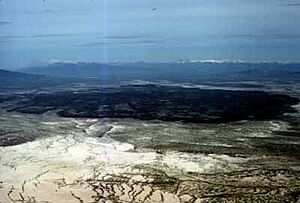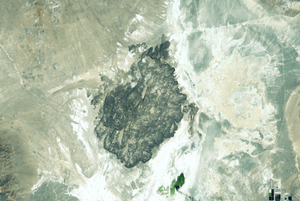Fumarole Butte facts for kids

Fumarole Butte is a shield volcano located in central Juab County, Utah, United States. A shield volcano is a type of volcano that looks like a warrior's shield lying on the ground. It has gentle slopes because it's built up from many layers of runny lava. Fumarole Butte was formed during the Quaternary period, which is the most recent period in Earth's history. It is made of a type of rock called basaltic andesite. This volcano stands about 207 meters (679 ft) tall and is about 12 kilometers (7 mi) wide.
Underneath Fumarole Butte is an area called Crater Bench. This area was formed by an eruption of basaltic andesite lava. To the east of the volcano, you can find several hot springs. These hot springs are known by different names, including Crater, Baker Hot Springs, or Abraham hot springs.
Contents
What is Fumarole Butte?
Fumarole Butte is found north of the Sevier Desert. It sits in a valley rich in scoria, which is a dark, bubbly volcanic rock. This valley is part of a larger lava field made of basalt. The volcano itself is built on top of older rock structures from the Tertiary period, which are made of rhyolitic lava. Fumarole Butte is made of both red and gray materials. Its rocks range from dark basalt to reddish scoria.
How Fumarole Butte Formed
Fumarole Butte began to form about one million years ago. This was during a time known as the Jaramillo normal event. As a shield volcano, it has a central part called a volcanic neck that sticks out. Around the edges of the volcano, you can find deposits from an ancient lake. This shows that the volcano was once partly covered by Lake Bonneville.
Fumarole Butte and Ancient Lake Bonneville
Fumarole Butte is located in an area that was once covered by Lake Bonneville. This was a huge ancient lake, covering nearly 19,750 square miles (51,152 km2)! Lake Bonneville formed more than 800,000 years ago. It grew very large because of heavy rainfall and melting glaciers.
Scientists have found that Lake Bonneville has dried up and refilled at least 28 times since it first formed. These cycles of the lake growing and shrinking match up almost perfectly with periods when glaciers were active. Scientists learned this by drilling into the ground and studying the layers of rock and soil, a process called stratigraphic studies.
Crater Bench Formation
The eruptions from Fumarole Butte created the basaltic Crater Bench Formation. This rock layer lies beneath the volcano's central neck. It is estimated to be around 900,000 years old, dating back to the Pleistocene epoch.
The Crater Bench area is broken up by faults, which are cracks in the Earth's crust. Its thickness varies quite a bit, from about 6 meters (20 ft) to 180 meters (591 ft). The main type of lava that makes up Crater Bench is aphyric basaltic andesite. This means it's a type of lava where you can see tiny crystal structures within the rock.



